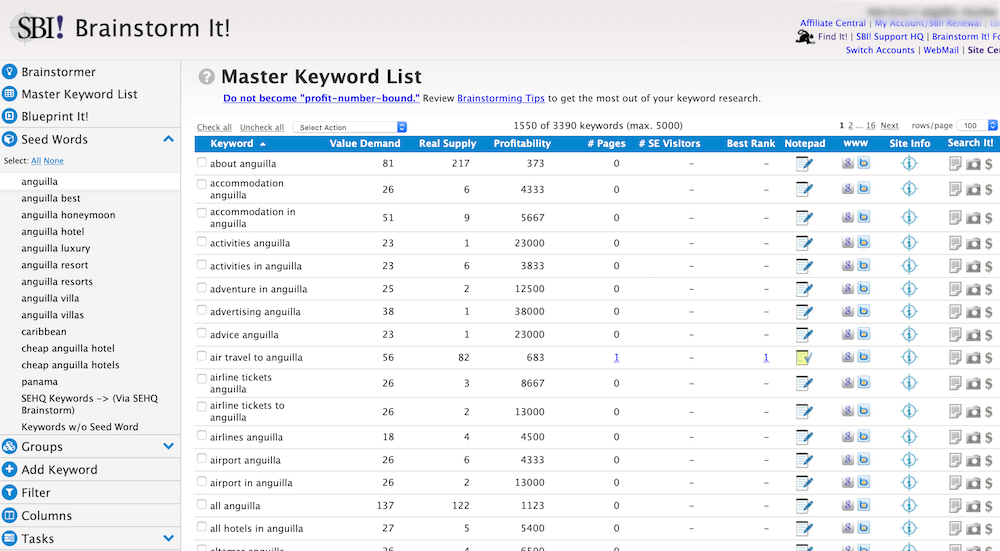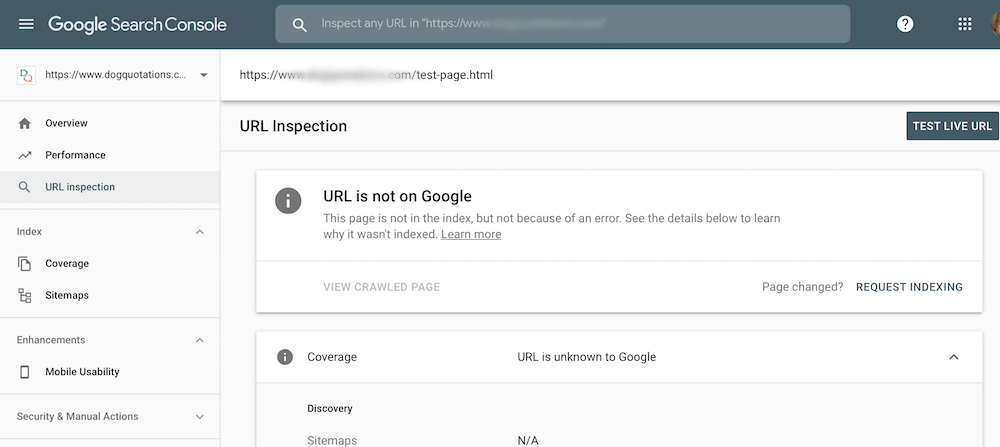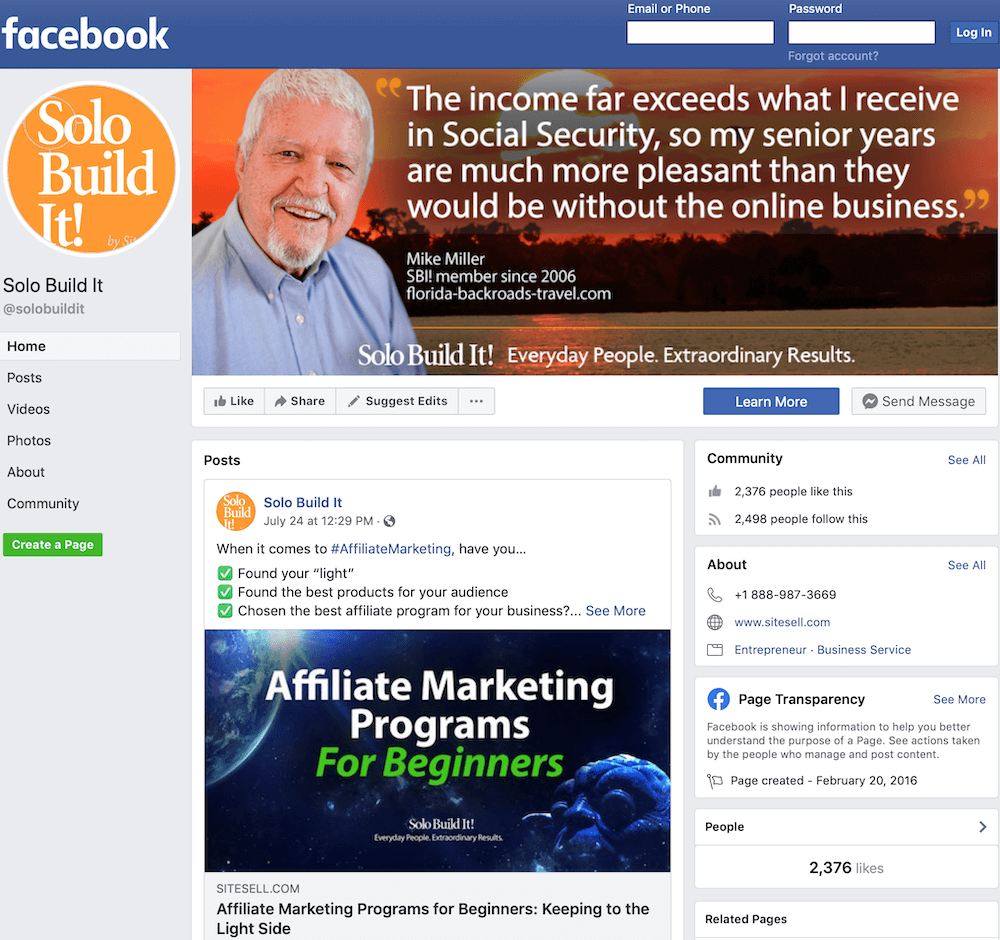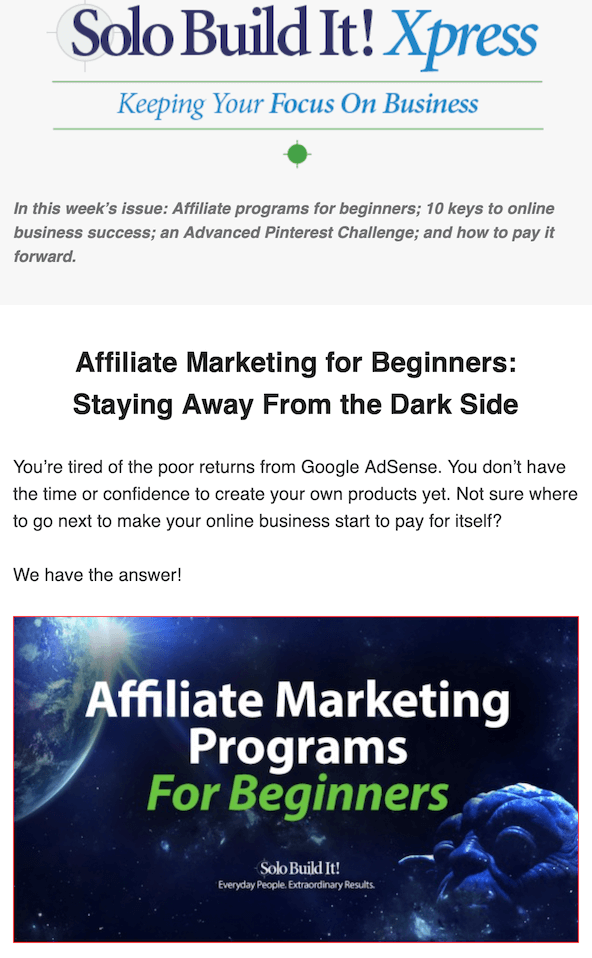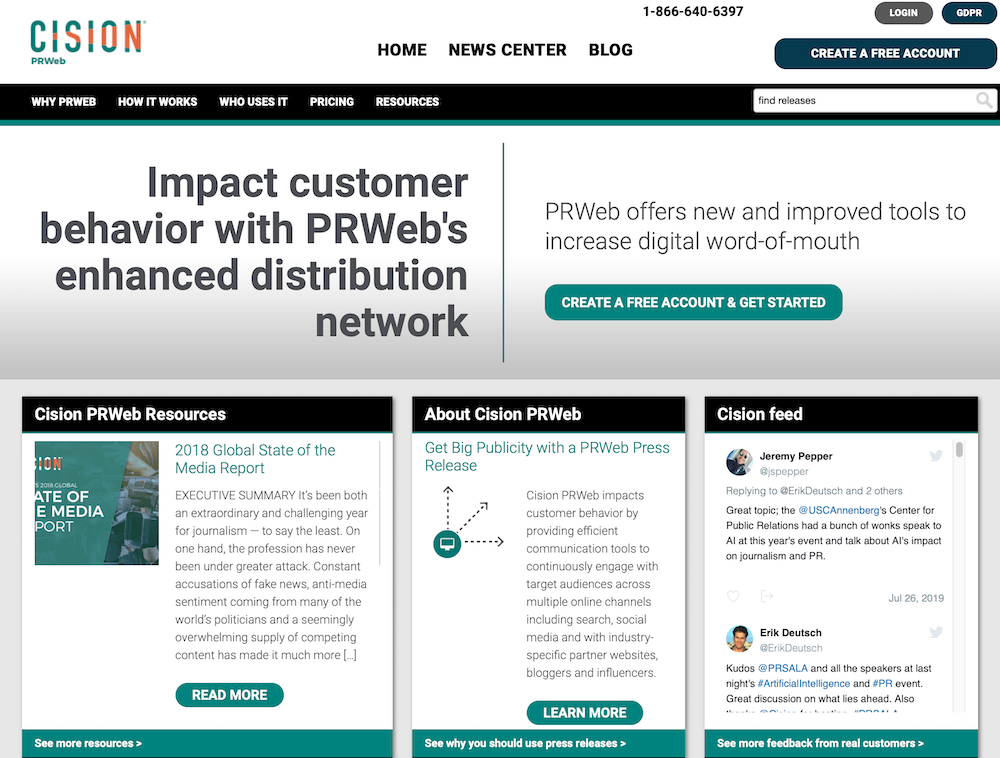
Early in your online business, the most pressing need is traffic to your website. Fortunately, you can be proactive — you don’t have to sit around and hope that Google ranks you at the top of the search results.
Whether you are trying to sell your first digital product or promote your first affiliate program, targeted website visitors are essential to your success.
This article discusses 23 ways for you to promote your site for free (although some have paid options). The only cost to you is your time, and the upside is more visitors to your website.
Here’s your goal for this list: Read the article, choose from the list, and take action!
How to Promote Your Website for Free
1. Write Brilliant Content
 There’s one method that you have complete control over when it comes to promoting your website or blog — publish so over-the-top excellent content that your visitors want to share it with their family or friends or those who share a hobby or passion.
There’s one method that you have complete control over when it comes to promoting your website or blog — publish so over-the-top excellent content that your visitors want to share it with their family or friends or those who share a hobby or passion.
It’s like watching a new movie that’s so fantastic that you rave about it to everyone, making them desperate to go see it.
Make your content that good and visitors will share it with others.
What if you already have a lot of “so-so” or even pretty good content?
Publish less new content. Spend the available time improving all your existing articles. Update old information, add new — make everything so good that visitors can’t resist sharing it.
2. How to Promote Your Website for Free on Google: Search Engine Optimization (aka Keyword Optimization)
There are many aspects to search engine optimization that you can use to improve your site’s rankings in the search engines.
- People are searching for (there’s a demand for it).
- Doesn’t have too much true competition (you have a chance to rank for it).
- You have something worthwhile to say about (you can create brilliant content for it).
The title you give a page becomes its clickable link in search results. Write a compelling title for your article and include the keyword in it — this is the formula to get on the first page of Google.
The description you give the page becomes the blurb below the clickable link in search results, if that description accurately describes the content your visitors will find upon landing on the page. Write a poor description, or no description, and Google will choose some of the page’s text to become the blurb in the search result.
Why give Google power over something you can control? Ensure that both the title and the description are so interesting that searchers can’t click on your link fast enough.
Of course, it doesn’t matter how good the title and description are if you don’t write about a keyword that people are using at the search engines.
How to find those keywords?
Well, you can guess, but unless you’re the world’s foremost expert in a very narrow niche, you probably won’t know all the best keywords to write about.
Here are two ways to get started finding profitable keywords:
Google’s Keyword Planner: It’s part of Google Ads, the advertising platform. You may have to set up an advertising campaign before you can access the Keyword Planner (if you do, be sure to pause the campaign before it starts!).
The problem with Keyword Planner is that its keyword numbers aren’t about people searching on keywords, but about people clicking on ads that contain those keywords. So you may be surprised by the results for some pages.
Solo Build It!’s Brainstorm It!: Use a keyword brainstorming tool that gives you numbers based on keyword searches instead of ad clicks. Solo Build It!’s Brainstorm It! collects keywords along with their demand and supply numbers, based on the niche-related search terms you enter.
3. Advanced Free Website Promotion on Google
Google Search Console (GSC) lets you immediately notify Google about your latest published page. Request indexing for the page within minutes of publishing it. If the page is high enough quality, it will be in search results in hours instead of days or weeks.
Then do the same thing with Bing Webmaster Tools. Submit page URLs as you publish, or wait and batch submit 10 or more of them.
How to Promote Your Website Using Social Media
4. Using Facebook Pages to Market your Website
Facebook was once excellent for free website promotion. Post a link to your new page, add a photo, and most of your fans would see your news. Now, only about 2% of a Facebook page’s fans see any given post.
Want more reach for your posts? You have to pay Facebook for that privilege.
If your online business is not yet at the stage where you can afford to promote your posts, consider the 2% good enough for now.
Here’s how to get the most engagement from your Facebook page:
- Post often
- Participate in comments
- Use lots of photos
- Of yourself participating in your niche
- Of your customers
- Images with relevant quotes
And don’t forget about Facebook Live. It’s an excellent way to create video content right on Facebook.
If a lot of your personal friends are also in your niche, consider posting on your personal page when you publish pages to your site. Do this sparingly though: you don’t want to bore everyone.
You can also make your business page pull its weight:
- Upload a cover photo (the large one at the top of the page) that’s related to your niche and your site.
- Add your logo or something else recognizable as your profile photo (at the top of the left column).
- Complete all the information on the About page, including your site’s URL.
And if you have a lot of niche videos gathering dust, upload the best ones to your Facebook page. Then post about them, adding a comment which will encourage people to engage with you.
5. Facebook Groups as a Marketing Tool
Where Pages are now meant as a means of a personality or business having an official profile, Groups are promoted by Facebook as the best way to engage your followers.
Creating a group and inviting followers of your page to join can be an excellent way of communicating with your fans — and, naturally, directing them to your website. Adding images, video and text content allows discussion of common issues in the niche. And, because members will see the group in their daily feed, you’re more likely to get contributors than relying on a page alone.
6. What About Twitter for Website Promotion?
Using Twitter is like moving a mile-long freight train loaded with lead. It takes a while to get it moving, but once it starts, watch out!
Depending on your niche, especially anything in the B2B (business to business) sector, Twitter could be the best social media platform for driving repeat traffic to your site. But it could take a while to get there.
Don’t give up if you don’t see results after a month or two.
Here are some tips to get the most from your Twitter promotion:
- Be consistent: Keep tweeting once or twice a day with news or other information about your niche.
- Retweet often: Share important tweets from others in your niche — they’ll notice and eventually reciprocate.
- Complete your profile: Include a niche-related cover photo, a headshot photo of you or perhaps your site’s logo, your (or your business’s) bio, and your website URL.
- Use images and gifs: These tend to get the most reaction (retweets, likes, and replies). You can even try the occasional quiz tweet to boost engagement.
7. Pinterest as a Website Marketing Tool
If you have an image-oriented website (e.g., travel, cooking), Pinterest could be the largest driver of traffic. It could send more than Google and Bing. So it’s worth spending some time setting up your Pinterest account and using it correctly.
Be sure to set up a business account, not a personal account. Then complete the profile, entering your business or website information.
Connect your Pinterest account to your other social accounts, so that you can share pins and boards to those connected platforms. Remember to go light on the self-promotion on all these platforms.
Set up boards that reflect the major sections of your site.
Pin some images from other sites that you think would help your followers. But remember that your account should be more about self-promotion, not promotion of others!
8. Can You Advertise Your Website on Instagram?
This is the “lifestyle” social platform for Millennials. If your niche is about something that interests that demographic, Instagram could be useful for you.
But you can certainly gain their attention with creative images and lots of engagement.
9. Website Promotion on YouTube
YouTube (YT) is the second-largest search engine in the world, so if your site has a how-to or instructional aspect, shoot videos of you walking through a set of tasks. Then post the video to your own YT channel.
Embed the video on the related page on your site as well, to help explain the steps visitors need to take.
Here’s what an embedded YouTube video looks like. Make sure you watch it. You’ll learn about one critical mistake you need to avoid in your keyword research. Knowing this simple tip will help you a lot with promoting your website on Google (what we talked about earlier).
Remember to add closed captions, and add a transcript of the words spoken in the video.
YouTube also lets you do live videos. So if you have a large following there, consider doing some live broadcasts.
Semi-Social Platforms as Website Promotion
These platforms are not “social” in the same sense as Facebook, where engagement is key, and they don’t necessarily provide the same opportunities for linking. Nevertheless, they can offer some interesting opportunities for establishing yourself as an authority in your niche.
10. Reddit: Promote With Caution
Reddit has over 138,000 subreddits or communities. So you should be able to find one that suits your niche and on which you can add well-thought-out commentary.
11. Quora
Quora is a question and answer platform, much like Yahoo! Answers was before it was “kidnapped” by spammers looking for inbound links to their sites.
It bills itself as “a place to share knowledge and better understand the world.” If you’re looking to build a reputation as an expert in your niche, answering questions here could give you a solid boost.
Go lightly when promoting your website though.
12. Medium
Medium describes itself as “trying to make it as easy as possible for people who have thoughtful things to say.”
Some people use Medium only, without a website, which indicates the power Medium can give you as a thought leader.
13. LinkedIn
If you’re in a business to business (B2B) niche, LinkedIn is the place to be. Reach out to others in your niche, curate content, and write your own.
People on LinkedIn are there to find a job, promote themselves or their business, or find someone to hire for a job or contract position.
You can’t go wrong on LinkedIn if you sell to other businesses. And it’s a free way to promote your website, although there are upgrade options with more tools.
Using Your List to Promote your Website
14. Website Promotion by Email Marketing
Starting an email list is one of the most effective ways to promote your website and your online business. Its biggest advantage? You have total control over it.
Set up autoresponders to drip content to your subscribers over several days or even a few weeks. This is especially useful for courses. Visitors complete a form to access the course or other content, and the first installment arrives in their inbox almost immediately.
If the course has enough high-value content, you can even charge a fee to access it.
You’ll need to use an email platform, like AWeber, ConvertKit, or one of over a dozen more options.
Never use your regular email service for email marketing. It’s against the terms of service. Your provider may shut down your account, leaving you scrambling to set up your accounts with another service.
Solo Build It! includes an email system and a newsletter system, which come free with all subscriptions.
15. Newsletter
A newsletter, instead of being on-demand content, is content you send out on a regular basis. It could be weekly, although creating that much content is a lot of work. It could be quarterly, but many of your subscribers will likely forget about you in the interim.
The best frequency is either every two weeks or monthly if you don’t have the time for more.
Newsletters don’t have to be lengthy. Here are some ideas for what to include:
- A link to an article on your website
- A bit of news about you or your business
- A special offer for that month
Be sure to go light on the explicit promotion. Give subscribers so much value that they want to do business with you.
Use the same email marketing platform that you use for your autoresponders. All of them allow you to segment lists, including having each person be on multiple segments. That way, you can move those people through a marketing funnel or customer journey, bringing them closer and closer to a sale.
16. Email Signature
You have complete control over your email signature, which goes out with every email you send. If you have employees who send emails on behalf of the business, their email signature should also provide promotional information.
Your email signature can include:
- A link to your website
- A short blurb describing a benefit
- Social media buttons
Don’t go any more promotional than that. You want readers of your emails to find your website — not to think of you as slimeball.
How to Advertise Your Website Using Public Platforms
17. Forum Posts
If your niche is more consumer-oriented (B2C), there are likely several forums about it. If you haven’t already, join them and see which might be the most valuable to you. Then answer questions, showing them your expertise or thought leadership. And comment on other posts.
Only then should you start easing a page of your site into a conversation, and only if it’s relevant to the conversation. You don’t want to be accused of spamming the forums — you’ll be kicked out quickly if you do.
18. Forum Signature
One thing most forums do allow is self-promotion in your forum signature. You’re often allowed a short blurb with a link to your site. Make it as non-promotional as possible while still giving it some value for your business.
19. Press Releases and Media Coverage
Press releases are a way to get information about your site into the hands of journalists and their editors at newspapers, TV and radio stations, and news sites.
The best press release sites charge a fee. Some are free, but we recommend using a paid platform, and only for your most important announcements.
The best of the paid press release sites is PRWeb, but it’s not cheap — you’ll pay around $189 per release.
This site lists 80 free press release sites. It lists PRWeb as a free site, so take the list with a grain of salt.
20. Help a Reporter (aka HARO)
Sign up to Help a Reporter and receive three emails a day from journalists looking for article help.
If you find a journalist or blogger’s request that matches your expertise or your niche, you can pitch them with answers to the questions asked, additional info, a short bio, and your contact information.
The journalist or blogger will reach out to you if they consider your pitch interesting.
This is a sign up and wait method of promoting your website for free, and can be frustrating if you spend time on pitches and never hear back. But it’s better than nothing, and could give you some major media exposure.
Use Yourself to Market Your Website!
Finally, don’t forget you are your most valuable resource in promoting your own website or blog. Put yourself out there to advertise your knowledge, experience — and your amazing content!
21. Respond to Comments and Engage in Conversation
 Allow comments on your posts — but remember to be there to engage.
Allow comments on your posts — but remember to be there to engage.
None of your visitors will want to engage with your content if you’re not there, making your presence known. If you don’t have time or don’t want to participate in the conversation, it’s best not to allow comments on your posts at all.
But if you work at it and your site becomes known as a place for vibrant, flame-free conversation, word will get out, attracting like-minded people in your niche.
22. Blogger/Website Outreach Marketing
Outreach marketing comes down to getting on the radar of known bloggers and influencers, eventually asking them to help you in some way.
This method takes time and energy. The best way to be noticed is to add valuable comments to their blog posts, or retweet their tweets, or repin their images, for example.
Once you receive a reply to your comment, or a direct message thanking you for a retweet or repin, let them know that you enjoy reading their work and find it valuable (if you do, of course — it’s essential to be genuine).
Send them an obscure blog post or tweet that they may not have seen. Continue to help them grow their business, without asking for anything in return. Eventually, they’ll give you a shoutout in a blog post or tweet, or perhaps even invite you to write a guest post.
23. Guest Posting (aka Guest Blogging)
Some blogs accept guest posts, if they meet the publication guidelines. Do a search for [niche] “guest post” OR “guest blog” to find blogs that allow guest posts.
Follow their editorial guidelines to the letter. If the blogger wants you to pitch an idea first, do that. If he or she wants to see a complete post, send that in, formatted as closely as you can make it to other posts on the blogger’s site. Include a few images as well.
Choose a Way to Promote Your Website to Suit You, Your Work Style, and Your Interests
That’s a long list of (mostly free) ways you have at your disposal to market yourself and your website or blog.
Unless you have unlimited time or a team of employees, it’s unlikely that you’ll ever come close to using all 23 of these methods — and not all of them will suit you or your niche anyway.
Wondering Where to Start?
If you haven’t already done so, spend time creating keyword-optimized, high-value content. No point sending people to your content if it’s not up to scratch.
Then pick 2 or 3 of these opportunities that you think are most promising. Learn how to work them until you’ve squeezed as many visitors out of them as you think is possible.
Once you’ve got the most out of your first choice, work your way through the rest of the list.
Choose the easier, “low-hanging fruit” options first. Those you think you can fit into your busy schedule — and that you might actually even enjoy!
Slowly graduate to the more difficult or time-consuming (and likely more valuable) options, until your site is receiving thousands of visitors a day. Once you have traffic, you can shift some of your focus to making money from your blog, with strategies like affiliate marketing or joining the Adsense program.
Need a way to remember all of these promotional opportunities, and which you’ve already used? Don’t try to manage it all in your head!
Download our free checklist now, and keep it updated as you work your way through the options.

Latest posts by Margit Streifeneder (see all)
- From Traffic Peaks to Auto-Pilot: A Psychologist’s Website Success Story - March 27, 2025
- From Swim Teacher to Solopreneur: Building Passive Income Online - February 27, 2025
- From Concierge to Global Tours: 10 Lessons for Travel Business Growth - December 19, 2024


